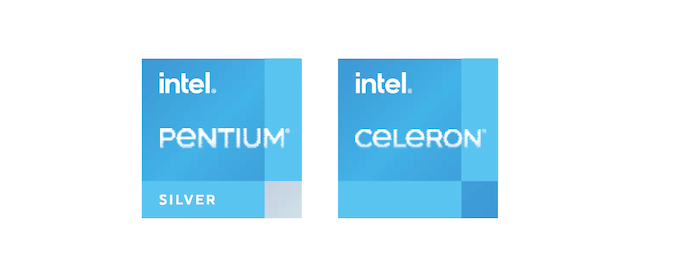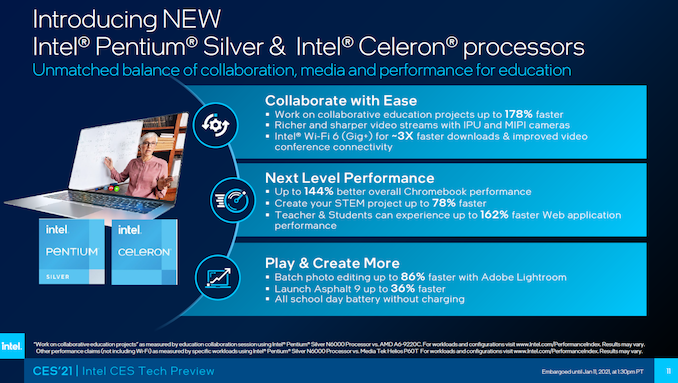Intel Launches Jasper Lake: Tremont Atom Cores For All
by Dr. Ian Cutress on January 11, 2021 4:30 PM EST
One of the more interesting elements in Intel’s 2020 set of disclosures was its 10nm Tremont Atom core. Initially used in the low power Lakefield product, this core design is super interesting due to its dual decoder design, which no other x86 core does. It has been over a year since the launch of Lakefield, and we’ve been hoping for a friendlier platform on which to test these new cores, along with some extra frequency to see the design stretch its legs. That platform is launching today, with Intel’s newest Pentium Silver and Celeron Processors.
The new Pentium Silver and Celeron processors are aimed initially at the education market, and Chromebooks, but will slowly expand into Linux and Windows variants over time. Intel detailed that the laptop market was priority over the mini-PC market, however other form factors are free to be developed. These new processors will follow the same schema as Atom-based Pentium and Celeron processors in the past, with quad-core and dual-core variants on offer. Intel has detailed six processors in total, three each at the 10W and 6W levels.
| Intel Jasper Lake | ||||||
| AnandTech | Cores Threads |
Base Freq |
Turbo Freq |
DDR4 LP4X |
GPU | GPU Freq |
| 10 W TDP | ||||||
| Pentium N6005 | 4C / 4T | 2000 | 3300 | 2933 | UHD | 900 |
| Celeron N5105 | 4C / 4T | 2000 | 2900 | 2933 | UHD | 800 |
| Celeron N4505 | 2C / 2T | 2000 | 2900 | 2933 | UHD | 750 |
| 6 W TDP | ||||||
| Pentium N6000 | 4C / 4T | 1100 | 3300 | 2933 | UHD | 850 |
| Celeron N5100 | 4C / 4T | 1100 | 2800 | 2933 | UHD | 800 |
| Celeron N4500 | 2C / 2T | 1100 | 2800 | 2933 | UHD | 750 |
All the processors will feature 1.5 MB of inclusive shared L2 cache, as Tremont is built around quad-core modules sharing an L2 cache – in this instance the dual-core variants simply have two cores disabled, but full access to the L2 cache. There is also 4 MB of non-inclusive shared L3 cache, which is a sizeable cache for an entry-level processor.
You can read the deep dive into the Tremont microarchitecture here.
All the CPUs support dual channel DDR4-2933, as well as LPDDR4X-2933, which is an odd combination as usually the LPDDR4X transfer rate is higher, such as LPDDR4X-3600. Graphics is provided by Intel’s UHD design, however it isn’t stated if this is Gen or Xe graphics, nor how many EUs these parts have. Through the stack we see a turbo frequency of 3.3 GHz, but Intel doesn’t specify base frequencies. In the footnotes, it does state that the turbo power is 20 W for the 6 W variants.
*Update: Intel's own specifications site, ARK, is now listing the base frequencies. We also have been told that the graphics are Gen11, not Xe.
A new features coming to these processors is Intel’s Image Processing Unit, or IPU, which when paired with a MIPI interface can enable accelerated compute for video calls and techniques, such as blurred backgrounds. Coupled with Wi-Fi 6 support (via additional RF), and the goal here is to provide a machine that can enable an education type workload.
The initial devices with these processors will be Chromebooks, which Intel compares itself favourably to AMD's A6-9220C, and MediaTek’s Helios P60T. Intel states a 35% generational improvement over Gemini Lake, and 144% better Chromebook performance (using PT’s CrXPRT benchmark) over the competition. Intel expects these devices to be in the market in Q1. Linux and Windows based devices are expected in Q2. Intel states that it will have 170 Chromebook designs in 2021, of which these processors will form a part of that mix.
Related Reading
- Interview with Intel CEO Bob Swan
- Intel at CES 2021: Overview
- Intel at CES 2021: Press Event Live Blog
- Intel Ice Lake Xeon in Production
- Intel 11th Gen Desktop Rocket Lake Core i9-11900K ‘Preview’
- Intel 11th Gen Tiger Lake-U Boosted to 35W
- Intel 11th Gen Tiger Lake-H with 8 cores
- Intel 11th Gen Tiger Lake Goes vPro
- Intel’s Next Gen Tremont Atom in Jasper Lake for Q1











31 Comments
View All Comments
mode_13h - Tuesday, January 12, 2021 - link
No joke. I went back to find their deep dive on the Tremont cores before the launch of Lakefield, and it was all the way back 15 months ago!I wonder if the product cycle of Jasper Lake is gong to be short, since I've already been reading about Tremont's successor, Gracemont, for a while. Isn't that what's supposed to be in Alder Lake, launching (allegedly) in H2 of this year?
CiccioB - Tuesday, January 12, 2021 - link
Don't really care for better/faster CPU that these, I just want a new CPU that uses 6W for a 24/24h on server (and possibly without a chipset that consumes even more that that).Git server is barely usable on this D510 when you try to clone a big repository with all the compression work needed.
mode_13h - Tuesday, January 12, 2021 - link
I hear you. I got an Apollo Lake board for use in an always-on, fanless, light-duty server. Unlike ARM SBCs, it has SATA onboard and a standard form factor that gave me the freedom to select an appropriate case.Namisecond - Friday, January 15, 2021 - link
It will probably be only Asrock with their crappy implementation like last gen and a half.mode_13h - Friday, January 15, 2021 - link
What don't you like about the ASRock boards? Just curious.For another option, check out SBCs, like ODROID-H2+ (except that's still Gemini Lake) or UPBoard. I think UP Board even makes some with Atom chips that support ECC memory.
PaulHoule - Tuesday, January 12, 2021 - link
"For All?"Does that mean Intel doesn't want us to have a choice.
Detroit kills off car brands like the Gremlin, Chevette, Neon, etc. When the quality is poop you just change the name and hope people forget. Contrast that to asian car manufacturers that would like to kill off quality brands such as the Fit and Civic but they know that would crater new car sales for a decade because it would drive up demand for used.
Intel should have given up on atom 10 years ago and they've had many opportunities and reasons to do so since and the fact that they haven't is proof that there is nobody driving.
CiccioB - Tuesday, January 12, 2021 - link
I have not understood completely this comment.. do you think that Atom like CPUs are useless?mode_13h - Tuesday, January 12, 2021 - link
It sounds like you haven't followed their coverage of Tremont. It's an impressive little core.https://www.anandtech.com/show/15009/intels-new-at...
ET - Wednesday, January 13, 2021 - link
35% gen over gen improvement is impressive.mode_13h - Wednesday, January 13, 2021 - link
According to this, they claimed 30% improvement in the previous gen (although there was Goldmont Plus, in between it and Tremont):https://www.anandtech.com/show/10635/intel-quietly...
Also, keep in mind that Goldmont was designed during the period when Intel was still targeting the cell phone handset market. So, power-efficiency was a higher priority for them than performance.